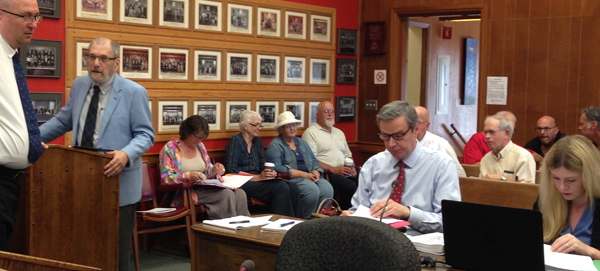OMB hears why County’s electoral wards do, and do not, meet criteria
Administrator | Jul 20, 2017 | Comments 7
 The Ontario Municipal Board will hear closing remarks in the hearing over Prince Edward County’s electoral ward boundaries Friday morning. However, OMB chair Mary Anne Sills has already noted the board will be reserving any decision until a thorough review of all documentation and statements has been conducted.
The Ontario Municipal Board will hear closing remarks in the hearing over Prince Edward County’s electoral ward boundaries Friday morning. However, OMB chair Mary Anne Sills has already noted the board will be reserving any decision until a thorough review of all documentation and statements has been conducted.
Thursday’s session at Shire Hall focused on statements by experts for each side, telling how the County’s electoral wards do, and do not, meet criteria to give citizens effective representation.
Dr. Robert Williams was first to speak during the second day of the three-day hearing. He was called by Cherry Valley resident Pierre Klein, who is appealing council’s January 2016 bylaw to a nine-ward plan (amalgamating Bloomfield and Hallowell and losing two councillors from the horseshoe (Bloomfield’s and one from Sophiasburgh).
Williams would like to see all the ward boundaries contain population roughly equal in size, with allowance for generally accepted percentage variations.
“Parity is a key factor. Prince Edward County’s is not a system that brings appropriate parity to the electors. There is enormous variation. There are some wards that are very small, others large. It’s complicated because of the idea that some wards are going to elect more than one person.”
“In my opinion the bylaw is flawed in a number of ways. It is basically a contrived response to a problem by simply saying we have to keep the old ward boundaries in place and get rid of Bloomfield, but everything else stays exactly the same. My sense is that does not adequately address the short-comings in the current system. The bylaw doesn’t enhance the system of representation in Prince Edward, which was the point of it.”
Addressing Williams, County solicitor Wayne Fairbrother challenged his interpretation of parity in the Supreme Court ‘Carter’ decision, noting Williams had paraphrased that ‘You can vary off parity when you have no choice, but when you do, you can’t go very far.'”
“What the Carter decision actually says, is that each citizen is entitled to be represented in government. Representation comprehends the idea of having a voice in the deliberations of government, as well as the idea of the right to bring one’s grievences and concerns to the attention of the government’s representative. That’s what the Carter case says. That’s a rather important statement.
“Parity, though of prime importance,” he continued, “is not the only factor to be taken into account in ensuring effective representation… Sir John A Macdonald is quoted as saying ‘It will be found that while the principle of population was considered to a very grave extent, other considerations were also held to have weight so that the different interests, classes, localities should be fairly represented; that the principle of number should not be the only one.”
Fairbrother’s witness list included John Maddox, who the board also qualified as an expert, in municipal affairs.
In times of population shifts, Maddox noted elected councils have the obligation to review boundaries to ensure balance and parity.
“I believe that generally speaking, they do that,” he said. “My review of the nine-ward proposal in the bylaw passed by council, in my opinion, respects existing boundaries, and communites of interest. I think it reflects some degree of service areas that quietly exist in those existing communities as well. Effective representation seeks relative parity, but the focus must be on effective representation, not some kind of mathematical science. It cannot be achieved with taking into account contributing factors like geography, historic boundaries and communities of interest. In my opinion the proposal has a reasonable balance of those ingredients that go into boundary consideration. ”
Three County residents who were granted participant status in the hearing spoke to boundaries and communities of interest points. They included Dennis Fox in support of Klein; Kathleen Vowinkel and David Mowbray in support of the municipality’s decision.
Fairbrother’s other witnesses were former councillor John Thompson who authored the nine-ward plan and Monica Alyea.
Thompson said there was no way to analyze if other plans were more popular than his, as stated in staff reports during the discussion of the final four options.
“The surveys were collected on paper, and online by Survey Monkey, and these can’t really indicate the public mood because participants are self-selected, or lobbied to participate by proponents.”
Alyea presented an impassioned explanation of several communities, their groups and services, and their importance to residents.
“I wanted to stay with the 10 wards for a very long time,” she said. “I held that position strongly. For me to get moved (by the nine ward plan), was exceptional…”I didn’t want to see this go to the OMB. I thought they came up with a solution that was sensible and respected communities of interest.”
The OMB’s jurisdiction allows it to reaffirm the ward boundaries bylaw, deny the bylaw or amend it.
Click here for information on day one of the hearing, and background. http://www.countylive.ca/?p=68115
Filed Under: Featured Articles
About the Author:

































Click the link to review the outline of the final argument from the County, at Friday’s hearing. http://www.countylive.ca/wp-content/uploads/2017/07/Final-Argument-.pdf
Thanks for posting that. Quite an impressive closing. Personally I am tired of voting for 1 rep while others get 2 or 3. My vote for Council does not provide me fair and equal representation.
Mr. Klein has forwarded a copy of his closing statement, delivered Friday, at the OMB hearing at Shire Hall.
Click on the pdf link here to read it:
We do not have voter parity in this County. Hopefully the OMB can provide what Council cannot.
Answer to your question about “what kind of democracy…………. is The City of Belleville.
You can live on one side of the street in Thurlow and have 2 reps on Council, or on the other side of the same street and have 6 reps. (Kind of a 3 to 1 ratio.) So it does happen in other places.
And we had 2 former councillors defending status quo. Voter parity and equality is paramount to this case.
As I asked at the OMB Hearing – what kind of democracy allows for the residents of one ward to have one vote and residents of another ward (like Ameliasburgh) to have 3 votes? In the case of Sophiasburgh – we lose a councillor – what is also interesting is that since January 2016, the date when the 9 Ward Plan created by John Thompson was passed by Council – no one from Shore Hall has bothered to inform the residents of Sophiasburgh of this basic change to their voting rights. Maybe Council wasn’t so sure that this decision was going to be upheld by the OMB??
Obviously after ten years of playing “political volleyball” with this issue, Council has proven that the issue of electoral change is too difficult for them to handle. It is time for the OMB to step in and make the decision for them – saving the taxpayers a lot of money too!